Section 4: Seed Dispersal
In the creation of the heavens and Earth, and the alternation of the night and day, and the ships which sail the seas to people’s benefit, and the water which God sends down from the sky – by which He brings the Earth to life when it was dead and scatters about in it creatures of every kind – and the varying direction of the winds, and the clouds subservient between heaven and Earth, there are signs for people who use their intellect. (Qur’an, 2:164)
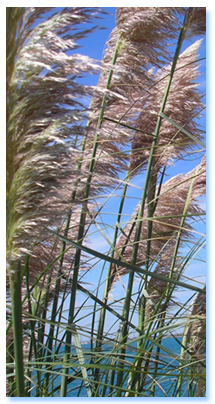 |
|
The seeds of bulrushes are dispersed by both water and wind. This plant has a mace-like section consisting of thousands of tiny tightly-packed fruits. As the picture shows, little tufts on the fruits allow the seeds to be transported when the time comes. (Grains de Vie, p. 40.)
|
Until now, you may never have wondered how plants, fixed life forms that are not capable of movement, manage to distribute their seeds. However, since the time plants came into existence, they have managed to distribute their seeds by various means, without the need for any assistance or intervention.
After pollinated flowers form seeds, some of these fall to the ground beside the plant. Other species’ seeds are carried by the wind, or stick to the fur of animals and are distributed in this way. But this summary of seed dispersion systems is quite superficial, for when you get down to the details, you can see that the lives of plants and animals are directly connected in a number of interesting ways.
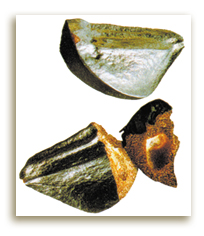 |
|
Lys de mer, a plant that grows on Mediterranean shores, has slightly angular seeds. When the outer case of the seeds matures, it takes on a mossy appearance. These seeds are also dispersed by floating on water. (Grains de Vie, p. 40.)
|
As you saw in the previous section, each plant’s seed has a different shape. From the shape of a seed or fruit, it’s possible to determine what kind of journey it has made – that is, how it’s been distributed. Some trees, for instance, have fruits that are colorful, fleshy, soft, and pleasant smelling. These trees, whose seed coats are tough enough to be resistant to digestive juices, attract birds and other animals. Other species’ seeds have needles, hooks or thorns that snag and get caught in the fur of animals, who transport them in this way. Still others travel on the wind, like so many feathers. Others have wings or swell like small balloons to help them catch the wind. Such seeds have to be light enough and of a suitable shape for flight. On the other hand, some plants simply let their seeds fall to the ground as the seed case splits as it dries in the sun, while others eject or propel their seeds, through the tension created in the seedpod while the seeds are growing.
From the examples given so far, the creation of a very detailed dispersion system is immediately evident.
The essential point worth noting is the perfection of each method of dispersion, despite all of the diverse structures. The systems never fail. Seeds carried by animals are invariably spread in this way, and the wind always carries those with the appropriate shape.
As the following examples will show, both animals and plants act in a remarkably conscious fashion in the course of these operations. But what is the source of this conscious planning? It’s of course impossible for a flowering plant to get together with a bird or a squirrel and decide to set up a dispersion system, or for these life forms to make a joint decision as to what each will do to operate the system. Plants are incapable of making a reproductive plan or setting up a system according to it. But when the time comes, every plant starts its reproductive operations, produces its seeds and distributes them in the necessary way. Throughout the world, each plant of the same species acts in the same way in the same sequence, using the same system.
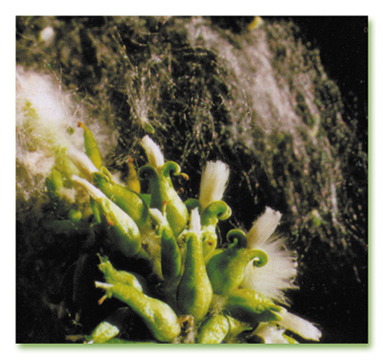 |
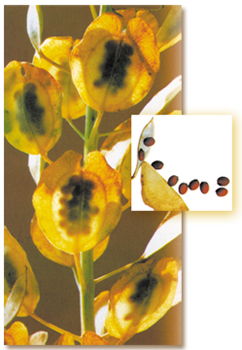 |
|
(Left picture) The willow (Salix) can reproduce very quickly and easily. Its seeds are dispersed by very diverse means as they can float on the air with ease and also on water. If the willow tree produces 500 catkins, and if each of these contains 100 seedpods and each of these pods contains 200 seeds, that means that 10 million seeds are produced annually. If every one of these managed to germinate, the face of the Earth would soon be full of willows. But thanks to the fine balance created in nature, this does not happen, and only a few of these seeds grow into trees. (Grains de Vie, p. 41.)
(Right picture) The seeds of the field pennycress are carried by rainwater. The seeds are marked with little scratches like fingerprints, which serve to increase the surface tension by which the seeds are easily distributed. (Grains de Vie, p. 42.)
Right: seeds of the Monnoyere
|
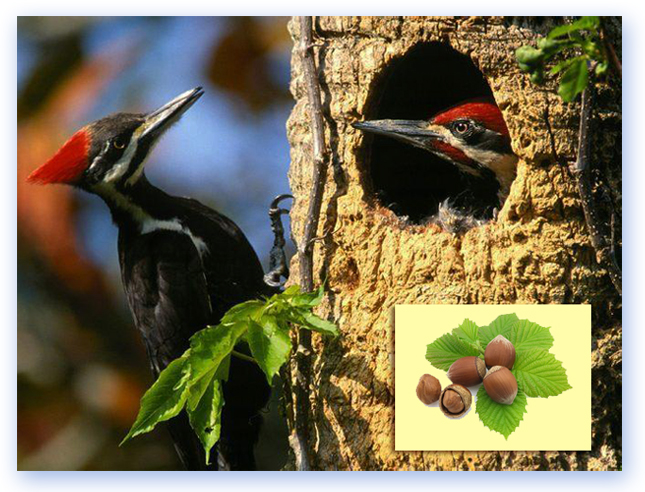 |
|
Heavy seeds – for example, hazelnuts, acorns and chestnuts – are normally quite featureless, lacking structures such as hooks or wings. For this reason they usually just stay on the ground where they fall, which is not usually conducive to germination. For each of these seeds to become a tree, it needs to go to a lighted place where it can easily develop. Interestingly enough, jays, crows, woodpeckers – and most importantly, squirrels – like eating these fruits and are the essential in the survival of oak and chestnut forests. The little creatures that collect the maturing seeds store them in various places, then forget to take back some of them from where they left. So the nuts can germinate and grow into trees. No doubt it is God Who creates the symbiotic relationship between these two living things.
|
Plants with Ballistic Knowledge
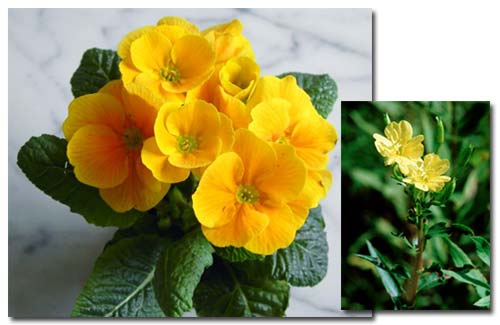 |
|
Seed capsules of the evening primrose open when they get wet, and the seeds are thus dispersed. (left picture: primrose)
|
For dispersion of their seeds, most plants require an outside agency – wind, gravity, or animals. But some flowering plants propel their seeds into the air when a drop of rain falls on them or when touched. For instance, the seeds of the evening primrose (Oenethera biennis) are stored in capsules which are sealed when dry. When these capsules get wet, they immediately open in the shape of a goblet. In this position, raindrops are enough to distribute the seeds. The henna plant’s yellow, orange and brown speckled flowers can be seen growing at any roadside. When touched, they propel their seeds like a pistol going off.
But this raises a very important point. As we know, plants are static life forms, unable to move around. But for them to be capable of propulsion, some form of energy must be required. This energy is activated during changes in the seedpod where the seeds are located. The pods crinkle as they dry in the sun, which generates latent energy. In much the same way, when the seed is moistened by rain, the swelling seedpod creates energy that can be triggered for propulsion.18
In such dispersion operations, finely balanced mechanisms are at work in plants. The timing of the plant’s dispersion of its seeds is also very important, as illustrated by the Mediterranean squirting cucumber.
A Natural Rocket System
Plants like the Mediterranean squirting cucumber generate their own force to distribute seeds. As the squirting cucumber ripens, it fills with a slimy juice, which gradually creates pressure until the cucumber bursts off its stalk. Behind it comes a trail of slime like the trail behind a space rocket. By this means, the cucumber’s seeds are dispersed on the ground together with the slime.19
At first glance, this mechanism seems like a plant just exploding at maturity, but it’s in fact very sensitive. It is of vital importance that when the fruit starts filling with juice is synchronized with the time when the cucumber and its seeds start to mature. For if the system were to operate before the seeds matured, there’d be no advantage in the cucumber bursting. This would prevent the plant from reproducing, and mean the end of the species. But thanks to the plant’s perfect timing, the system starts to function and disperses the seeds at exactly the right time.
This fine timing holds true for all plants that disperse their seeds by propulsion. That this works without a hitch raises the question of how any such system came to exist at all. As we have seen, plants need an integrated system in order to reproduce. It is illogical and unreasonable to claim that this mechanism – which must have been present in each plant simultaneously, from the very start – has evolved as a result of changes taking place over thousands, even millions of years. The maturing of the fruit, the fluid it contains, and the seeds must all emerge at the same time. Any hitch would mean that the plant could not disperse its seeds. Take any component you choose out of this system; the result will always be the same: extinction of the species.
The details that go into the distribution of just a single seed plainly show how perfectly and completely plants have come into existence. This cannot have been achieved through pure coincidence, or random natural events. The obvious truth is that God, the Creator of all things, has created them in all their perfection. There is no other deity than Almighty God. Thus it behooves all intelligent people to live in the knowledge of this truth and to be directed to God in everything they do.
Your deity is God alone, there is no deity but Him. He encompasses all things in His knowledge. (Qur'an, 20:98)
Examples Drawn from Other Plants
The broom is another plant that reproduces by opening its seedpod of its own accord, but in a completely different way from that of the Mediterranean squirting cucumber. The broom’s pods burst as a result of evaporation rather than as a result of an increase of liquid in the plant. As the heat rises, the side of the pod facing the sun dries out faster than that in the shade, which creates a tension in the pod. Finally it splits suddenly into two halves, and its tiny black seeds are dispersed in all directions.20
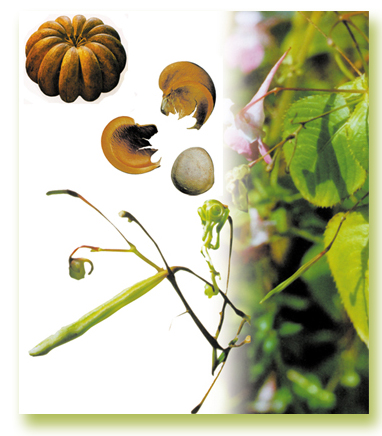 |
|
Above right:The Hura plant disperses its seeds by bursting the seed case. Right: Impatiens balfourii has a very original dispersion technique. The pods burst on contact, scattering their seeds. They do not remain flat, as they appear in the picture, but become rounded due to pressure between the outer layer enclosing the seed and the protective inner layer.
|
The seedpod of a tropical tree called Hura crepitans, consists of a dozen small chambers fused together. The seedpods burst noisily in the heat of the sun. After the seedpods pop, the seeds and split pods are scattered in the surrounding environment. Hura crepitans is one of the most successful at propelling its seeds to great distances. When the time comes, it can hurl them up to about a few meters.21
The Geranium’s Effective Propagation Methods
 The geranium (Geranium pusillum) has a most interesting and effective way of reproducing. This variety of plant is a ground creeper, which disperses its seeds by an interesting propulsion method. The fruit of the geranium, which develops to form a spike extending from the fruiting body, acts as a kind of catapult. The geranium (Geranium pusillum) has a most interesting and effective way of reproducing. This variety of plant is a ground creeper, which disperses its seeds by an interesting propulsion method. The fruit of the geranium, which develops to form a spike extending from the fruiting body, acts as a kind of catapult.
Each of the six fruit capsules around this spike is located at the end of a flexible strip. When the fruit is ripe, the strip violently recoils, making the capsule snap upward and casting the seeds.
The seeds shoot upwards along a certain trajectory and fall at a distance. This is a perfect mechanism. But for optimum propulsion, there should be no obstruction in the seeds’ path.
Under such circumstances the seeds could just as easily be dispersed by a strong wind. However, to prevent this happening, small filaments at the entrance of these sections keep a light restraint on the seeds.22
Wherever geraniums grow in the world, this mechanism is perfectly preserved. If this were not so, geraniums could not reproduce, and the species would die out. Obviously this intricate and perfect order has not come into being of its own accord.
God, Who has perfectly created all living things on Earth, also created geraniums in such intricate detail.
The Incredible Twisting Mechanism of Erodium
As in the geranium, the fruits of the Erodium plant (stork's bill)come together on their syles at one central point. The seeds are located inside the fruits shown in the illustration. At maturity, the stamen attached to the seed starts to curl, extending towards the ground. This is when the plant’s amazing mechanism comes into play, letting its seeds screw themselves into the soil. The system consists of the following:
1-The top of the tail on the ripening seed curls into a vertical position. When the tail is twisting into the soil, it functions as a lever.
2-The bottom of the tail is twisted and screws into the soil, functioning like an engine to drive the seed into the earth.
3-The filaments surrounding the tail are long, closely woven and stick in like thorns, providing support.
4-The head, carrying the seeds inside, is like the pointed tip of a cork screw, driven into the earth by the action of the lever at the top.
5-The hairs on the head, short and regular, ease the seed’s passage into the soil and at the same time, act as a kind of fishhook to prevent the seed being pulled out again. The big picture to the left shows Erodium seeds anchored to the ground.23
The ability of this soft plant to pierce hard ground is naturally not the product of coincidence. God, Who has no partner in His creation, acquaints us with His art with the system installed in this incomparable plant.
Seeds Dispersed by the Wind
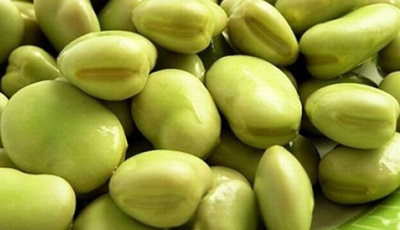 |
|
On maturity, the seedpods of most plants like the broad bean split open as the tissue dries out. The seedpods wrinkle and twist open. The cells of the tissue of the opening section of this plant are arranged in a weak line, so that any amount of pressure causes the pod to split often very suddenly.
|
Seeds carried by the wind must be light enough and of a suitable shape to be airborne. For instance, any seed the size and shape of a hazelnut or a coconut cannot take to the air. For this reason, all seeds borne on the wind are very light; and bear feathery or wing-like structures.
The great majority of wind-borne seeds have matured by the beginning of autumn, when the winds are strongest. Remarkably, the autumn winds begin just at the time when the seeds mature.
The plants whose seeds are dispersed by the wind differ from each other in their structures, in much the same way as do the plants themselves. For instance, in the North African deserts, fruits and seeds are either winged or light and fluffy. The fruit and seeds of plants of the Nubian Desert in Northeast Sudan and the North American deserts are dispersed by light winds. In the Middle East and North Africa, plants assume a round ball-like shape and in times of drought are dragged around by the wind.24
The dandelion, lettuce, and thistle are a few of the plants whose seeds are dispersed by the wind. Another example is the groundcherry, whose seeds are in paperlike sacs that have air in them and act as small balloons to help them move in the wind.25
An important point to be borne in mind is that it’s impossible for a plant’s reproductive system to change over time. For example, a plant whose seeds are being carried by animals and buried in the ground cannot, over time, become light enough to be carried by the wind. However much time passes, be it even millions of years, a heavy seed like an apricot pit cannot become light and develop wing-like structures. Such a claim can’t be reconciled with scientific logic, because the plants and animals, or any other elements found in nature, do not engage in such planning. The plant is not able to bring about the conscious organization in seeds.
 |
|
The stages of the thistle display a fine system, from the formation of the flower to the appearance of the seeds.
|
Thinking about these facts, you can immediately understand that seeds have had the features they now possess since they first existed. This is one of the countless pieces of evidence that seeds were created in an instant. There are evident signs of creation in the structures of seeds that let them be transported, and this creation is God's, Who has eternal knowledge.
On examining the air-borne Zanonia seed, engineers who study the principles of flight have discovered some interesting things. They studied its center of gravity, the point around which its weight is evenly balanced. If the center of gravity were moved any further back, the seed would move more slowly. However, thanks to the Zanonia seed’s perfect shape and general structure, the breeze can easily carry it for long distances.26
Special Structural Features that Help Seeds to Fly
The mobility of wind-borne seeds does not depend on just the size of the seed, height of the plant, or wind velocity. One of the most important features is the seeds’ special shapes and appended structures, which let flying seeds be basically classified as those with wings or parachutes, powder seeds and fluffy seeds.
 |
|
Each of the airborne seeds in the large picture will become a new dandelion if given the right conditions.
|
Propeller-winged Seeds
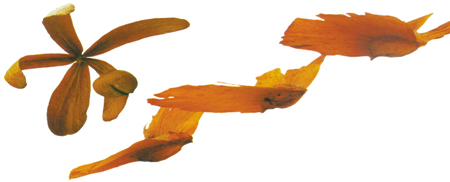 |
|
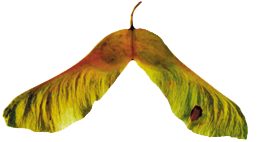 The Terminalia plant has V-shaped wings. The Terminalia plant has V-shaped wings.
When the airplane was invented, inspiration was taken from birds. The inspiration for a helicopter came from dragonflies, and from plant seeds that spin around a central point. Pictures are examples of seeds of plants that disperse their seeds by air.
Maple seeds hang on the tree like pairs of wings.
|
The European maple, using air transportation for reproduction, has seeds with an interesting structure; they are equipped with a single wing, sprouting from one side.
When the wind is strong enough, these tiny helicopters spin around.
Each mature wing has a membranous appearance and its veins give it the appearance of an insect’s wing.
The maple seeds’ structure lets them spin in the air, letting them stay longer in the air.
When the wind drops, the seeds spiral slowly to the ground.
As the European maple is thinly dispersed in the region where it grows, the wind is one of the main aids in its dispersal.
Thanks to this feature, the helicopter seeds, which are created to spin even in a light breeze, can sometimes travel many kilometers.27
The Terminalia calamansanai has seeds with V-shaped wings, thanks to which they can glide on a gentle air current much like a paper plane.28
 |
|
The seeds of the maple have structures like helicopter propellers that enable the seed to spin through their air, often covering a distance of a few kilometers.
|
Parachute Seeds
 |
|
Plants with small seeds such as red valerian (Cetranthus ruber, below) and Silybum marianum (right) usually have parachute seeds. (Grains de Vie, p. 56.)
(left) Moonflower (Scabiosa stellata) is an example of a flying seed with a membranous structure.
|
People jump from great heights safely, with parachutes whose specially designed shape lets the user glide through the air. Some seeds also have similar structures.
When they mature, parachute seeds do not immediately fall to the ground, but wait for a strong wind to carry them further away. If this were not the case, they would fall so close to the mother plant that their chances of getting enough sunlight would be reduced.
The speed of parachute seeds depends on their size and whether they are porous. The larger the parachute, the slower the seed can travel. And the less porous the parachute is, the more sensitive it will be to air movements. Even seeds with this porous structure show variations, such as the simple silkiness of Silybum marianum, the feathers of the thistle (Cirsium occidentale) and the membranous structure of the moonflower (Scabiosa stellata).29
As these few examples show, parachute seeds include all the necessary features to increase the speed of the seed and enable it to move more easily.
To show that these features are not products of coincidence, consider the parachutes used by people. No one would hesitate to agree that they have a special design. A parachute cannot just produce itself; someone first thought of it and tested it out.
People produce the threads used in the making of the parachute, a factory weave this yarn into fabric, and then people sew this fabric together to make a parachute. It’s obvious that static pieces of fabric cannot assemble themselves to make a parachute and acquire the aerodynamics to let it coast through the air.
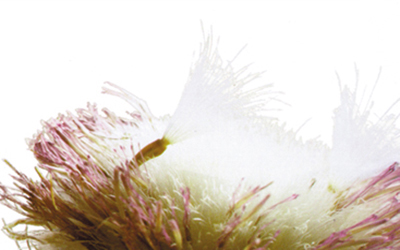 |
| God has created the tufted seeds of the thistle with the most suitable shape for being carried by the wind. |
In that case, how come there are seeds with even more complex parachute-like structures? Who made such decisions as whether there would be few or many pores? Those who might reply that such details are “coded into information in the seeds” should explain how the first seed appeared, and how this information came to be installed in it. This first seed could not have acquired such knowledge on its own, as a result of coincidence. The unconscious molecules that compose the seed cannot just have come up with a plan one day, saying, “Let’s make a thing called a seed, and code it with information on how to create thousands of different varieties of plants.” No intelligent, logical person could make such a claim. If it’s obvious that no parachute can produce itself, then seeds resembling parachutes with such a detailed structure cannot come into existence of their own accord.
However hard they try, evolutionists cannot attribute the formation of seeds to coincidence. In an evolutionist work called Grains de Vie [“Seeds of Life”], the parachute-like structures on seeds is expressed as “an unresolved subject:”
Not yet understood is how evolution could develop devices so finely adapted to flight.30
As the above quote shows, evolutionists attribute independent powers to an abstract, imaginary concept like evolution. They refer to evolution as if it were a power that can organize, develop and create something. But “evolution” is not a power. Its acknowledged mechanism is coincidence – an uncontrolled process. It does not have the power to create perfect systems.
Seeds have been brought into existence by a Power that knows how to put into them the necessary information, what kind of environment they will sprout in, and what systems they will need to complete these features. This is plainly a power like no other, and is the power of God Who created the universe and formed everything in a perfect order. It behooves every person of intelligence to observe the order in the universe and consider what God has created. In a verse of the Qur’an, He makes known that there is no other deity and that the only salvation is to pray unto Him alone:
Did you suppose that We created you for amusement and that you would not return to Us? Exalted be God, the King, the Real. There is no deity but Him, Lord of the Noble Throne. Whoever calls on another deity together with God, has no grounds for doing so at all and his reckoning is with his Lord. Truly the unbelievers have no success. (Qur’an, 23:115-117)
Dust-Like Seeds
When the seedpods of the poppy and the snapdragon sway in the wind, thousands of fine seeds are dispersed into the environment. These seeds are so small that they look like specks of dust in the air. The upper sections of the pods containing the seeds are pierced with little holes like the top of a saltcellar. In fact, at the beginning of the last century, R.H. France, the inventor of the saltcellar, was inspired by the finely crafted structure of these plants!31
 |
|
When plants like the snapdragon (above left) and the poppy, whose seedpod is shown in cross-section above, are shaken by the wind, they disperse thousands of seeds. The picture to the left shows the flowers of the poppy.
|
 |
|
snapdragon and its seeds
|
The seedpods of orchids have three compartments. When these pods mature they burst, scattering clouds of tiny seeds that are practically weightless and have no reserve of nutrients. Even the embryo has not developed fully, and so orchid seeds need very special conditions to germinate. But this is no disadvantage, because as many as 2 million seeds may be produced from a single orchid seedpod.32
Fluffy Seeds
Just like the seeds with parachutes, fluffy seeds do not fall straight to the ground. Clematis, for example, waits for the wind to make their mother plant sway and carry the seeds away. Plants like pampas grass with their long, feathery plumes wave in the wind like flags, letting their seeds be carried far by the wind.33
 |
After pollination, the clematis (far left) extends out its characteristic tendrils densely covered with hairs. The two pictures above show the seeds of the cotton plant.
|
Plants Whose Seeds Are Dispersed by Water
 |
|
Coconut starting to germinate on reaching the shore
|
Plants growing on the seashore or on riverbanks use the nearby water to disperse their seeds. To achieve this, these seeds must be water-resistant and have very special structures. Waterproof and unsinkable, they are created to be resilient enough to preserve their ability to flourish, even after a prolonged journey in seawater.
The seeds of such plants are rendered waterproof by their thick, glossy outer shells. They are able to float, sometimes due to an air chamber or their airy, spongy structure; or sometimes, as in the case of small seeds, thanks to water’s surface tension.
Coconut palms can be found on tropical shores all over the world. The coconut seed, one of the seeds dispersed by water, is contained in a hard shell to provide safe travel. Everything it needs for its long journey, including fresh water, is contained inside this hard shell. The tough texture of the outer layer protects the seed from the harmful effects of water. One of the coconut’s most interesting features is the air spaces and corky floats that keep it afloat, enabling it to travel thousands of kilometers on oceanic currents. When it reaches the shore at high tide, it lodges in the sand, the seed within germinates and grows into a new coconut tree.34
Coconut is most successful at dispersing its seed by ocean currents. What essentially prevents coconut from sinking is its fiber float, where air gets trapped between the fibers. In addition, its outer shell is smooth, polished and waterproof, characteristics that enable it to remain at sea for months.35
Another of the seeds traveling in tropical latitudes is one of the large legumes, the sea-bean, whose seeds are not as big as those of the coconut and only use rivers for transportation. Their very thick and waterproof outer shells and great longevity make them a most successful traveling plant. Thanks to the air chambers in the seeds, they do not sink in the water. 36
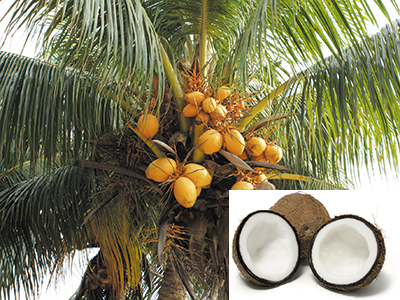 |
|
The coconut disperses its rather large seeds by water. The size of the seeds determines the amount of nutrients reserved for the ensuing journey.
|
The seeds of sea heart (Entada gigas), a tropical African sea-bean, have an interesting heart shape. The seeds grow inside the seedpod, which is of great dimensions. Violent rain can carry seeds of this plant, which grows on the banks of rivers, as far as the Atlantic Ocean, where they go on journeys lasting for years and reach places as far as Europe, the Gulf of Mexico or Florida.
The seeds of gray nickers (Caesalpinia bonduc) can also travel long distances on sea currents. This small, round gray seed does not sink, thanks to an air chamber under its thick coat. It can stay at sea for years without losing its ability to germinate.
Another plant whose seeds are dispersed by water is the sea daffodil (Pancratium maritimum). This plant, found on sandy Mediterranean and Atlantic shores, is distributed by means of its angular black and incredibly light seeds, which are enclosed in a seaweed-like casing.37
The tiny seeds of plants like nasturtium (Tropaeolum majus) are covered in a hydrophobic polish that lets them make use of surface tension to keep from sinking. By this means, the seeds are able to travel by floating along rivers.38
Seeds distributed by water are formed so as to reduce their weight and increase their surface area. Air-filled buoyant structure is usually found in fruits and seeds. Their floating tissue can take a variety of forms, but is likely to be a spongy structure with air-filled cells, or a structure of tightly packed cells that traps air inside. In addition, the cell walls have to prevent the entry of water, and there must be an inner layer to protect the plant’s embryo and its genetic information.39 This evident arrangement in seeds is just one of the countless pieces of evidence of God’s creation on Earth.
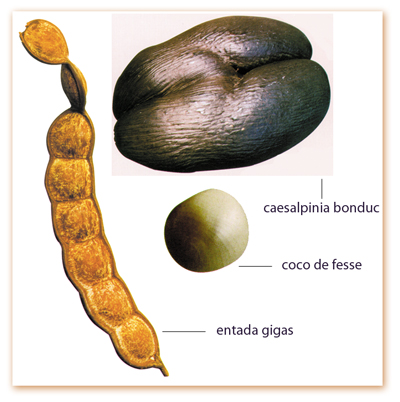 |
|
caesalpinia bonduc: coco-de-mer seed
coco de fesse: gray nicker seed
entada gigas: sea heart seedpod
Some plants with quite large seeds need water to reproduce, but contain everything they need, containing a store of nutrients sufficient to last for the journey, corky floats to keep them on the surface of the water, and an oily surface.
Coco-de-mer, also known as double coconut, produces nuts weighing up to 20 kilos (44 pounds), the largest seed in the world. The seed can float thanks to a kind of air compartment. Water-repellent oils and chemicals in the seed help to increase its resistance to moisture. (top)
|
As seen from the examples in this section, the most important characteristic of seeds transported by water is that they germinate once they get to land. This is an exceptional situation, because as we know, seeds usually start to germinate when they come in contact with water. However, plants using water to disperse their seeds are different in this respect thanks to their seeds’ special structures. If these seeds were to start germinating as soon as they came into contact with water, their species would have died out long ago. However, thanks to mechanisms suited to the conditions they live in, these plants can perpetuate themselves with ease.
All plants on Earth enjoy the structures most suited to them, with exceptional characteristics unique to each species. Why are the features of every kind of plant in perfect harmony with its environment? And how did such features come into being?
Taking plants that disperse their seeds by water as an example, we see once again evidence that these species couldn’t have appeared by chance. For the seeds of these plants to remain viable in water for so long, they need to be more resilient than average, with casings that are quite thick and special structures to protect the embryo from water. Obviously, such structures are not formed by coincidence, much less by the plant’s own efforts. On their long journeys, moreover, the seeds will need more nutrients than usual and exactly the right amount of nutrient is installed in them. Evidently this characteristic could not occur by chance. It is evident that chance could not calculate the amount of nutrients a plant needs for its journey and then provide the seed with exactly that amount. In contrast to all other plants’ seeds, these do not germinate in water, but as soon as they come into contact with land. Such timing could not possibly be achieved by coincidence.
All these delicate calculations and measurements are carried out to perfection by God, the Creator of seeds, Who knows all their needs and characteristics. He has eternal intelligence and knowledge. A verse of the Qur’an tells how God has created everything in due measure:
As for the earth, We stretched it out and cast firmly embedded mountains in it and made everything grow in due proportion on it. (Qur’an, 15:19)
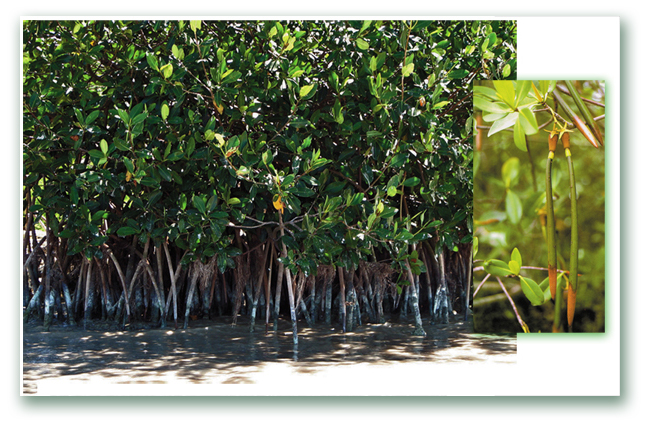 |
|
Mangrove forests are one of the most fertile regions on Earth for a variety of fauna and flora. They are usually formed by groupings of mastic trees. Plants like Rhizophora and Ceriops growing in these regions have a very interesting method of reproduction. These plants' roots develop in the air, arching back down into the alluvial mud. Seeds start to germinate and develop into shoots before they separate from the mother plant. After a time these shoots fall off into the mud and rapidly put out roots to ensure that they are not washed away. (Grains de Vie, p. 40.)
|
Plants that Get Others to Disperse Their Seeds
As you wander through long grass, the seeds that stick to your clothing or your dog’s fur have special structures that let them be carried in this way. To cling to animate objects, some of these seeds use needles, hooks, tacks and thorns. Other species have attractive smelling, colorful or tasty fruits, as though they are decoratively created in terms of color, smell, shape and presentation, to entice animals into carrying them away. The fruits, which are rich in sugar, water, energy and mineral salts, are attractive to animals that eat them, thus helping proliferate plants by dispersing their seeds over a very wide area.
Symbiotic Relationship between Ants and Plants
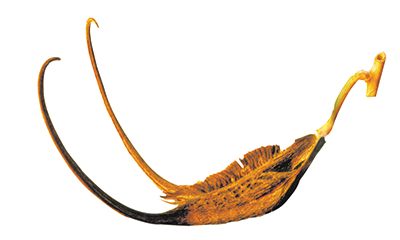 |
|
As the illustration to the left shows, the fruit of the devil's claw (Ibicella lutea), growing in Mexican scrublands, produces seedpods with two formidable horns – a good means of protection, since no animal dares to eat them. The seeds use their horns to attach themselves to passing animals and travel to new locations. (Grains de Vie, p. 45.)
|
As just mentioned, some plants’ reproduction depends on animals to carry their seeds. This shows an interesting harmony between plants and animals. To illustrate, let’s take a seed covered in an oily, edible tissue, called an eliasome. This tissue, seemingly quite ordinary at first glance, actually plays a vital role in the plant’s survival, for it is the reason why ants are interested in the plant and play a role in its proliferation.
As with almost every other seed, this one must also go underground in order to germinate, and to make germination happen, the core of the seed must be exposed. The plant cannot do this by itself, but ants can. To them, the oily covering is a very attractive food, so they collect the seeds with great zeal and carry them to their nests. Thus initially, the seeds are carried beneath the soil.
Then begins the second important stage for the seeds. Having spent lots of effort to carry them to their nest, the ants gnaw off the eliasomes and abandon the seeds themselves. In this way, the part of the plant that allows for reproduction reaches an ideal position underground.41
So how did this harmony between ant and seed emerge?
Of course, that the ant does this consciously, acting in knowledge of what the seeds need to sprout is an untenable idea. And it’s completely unreasonable to theorize that the ant discovered the seed by accident one day, took it underground and, seeing that it grew into a plant, informed the next generations of ants that they should do the same thing. It’s equally preposterous to claim that somehow, the plant learned what this species of ant likes, and tailored its seeds accordingly in order to reproduce.
 |
 |
|
Seeds of wild barley (Hordeum murinum), one of the gramineae, are covered in fine hairs and employ a special system for clinging to passers by. This system is so effective that every movement makes the seed cling more tightly to the spot where it's attached itself to. Thanks to the micro-husks at the tip of the thorns, the seeds at the bottom are protected from any dangers they may encounter. (Grains de Vie, p. 46.)
The seed head of the rose clover (Trifolium hirtum) is covered in fluffy hairs. If an animal brushes against it, this structure around the fruit breaks, and the seeds are scattered in the wind. (Grains de Vie, p. 46.)
The digestive system in mammals works much more slowly than that of birds, so that seeds ingested by mammals can be carried far greater distances. For example, large herbivores like African elephants play an important role in dispersing seeds, and the germination of some species like Baillonella toxisperma, native to Western Africa, depends entirely on elephants. (Grains de Vie, p. 49.)
|
This harmony must have been specially arranged, because this plant’s very first seeds had no other mechanism by which to reproduce. If it hadn’t been able to attract the attention of ants, there would be no likelihood of its continued existence. (And if the ants didn’t exist, they would have no way to survive.) But the reality that this plant's existence shows us is plain to see. The consciousness behind this perfect harmony is neither the plant’s nor the ants’. The supreme source of this consciousness is God, Who knows the characteristics of these two life forms and has created them in harmony with each other. God makes known how every living thing is submissive to Him in a verse of the Qur’an:
Everyone in the heavens and Earth belongs to Him. All are submissive to Him. (Qur’an, 30:26)
 |
|
Mistletoe (Viscum album) stays green all through winter when its host trees have all lost their leaves. Throughout the winter season it produces small seeds that usually germinate on the trunks and branches of other trees rather than on the ground. So how is this done?
The seeds have to cling to a branch of a host tree and not fall to the ground if they are to germinate. But under normal circumstances, the rounded seeds would fall directly to the ground. This problem is solved for the mistletoe seeds by the thrush, which is very partial to mistletoe seeds. This is very important, because in order for the plant to reproduce, its seeds must pass through the thrush's digestive tract. In the belly of the thrush, the seeds are coated in a very effective substance called viscin, which, after passing out of the bird's body, bonds the seed to the host. In this way, a new parasitic plant starts to germinate. (Grains de Vie, p. 47.) It is quite thought-provoking that reproduction in the mistletoe is linked to the thrushes' love for its berries. Obviously this association is no coincidence. Mistletoe has used this method of propagation since it first existed, for this is how it has been created. It is God Who makes the two life forms aware of each other.
|
 |
|
Pine trees disperse their seeds by various means. A pine cone stores many winged seeds, each in a separate compartment. The seeds stay packed tightly in closed cones for approximately three years. Then, they begin to open with the heat of the summer sun and so are scattered through the air.
The seeds are also dispersed by being carried off by squirrels. Usually in summer, squirrels snap off short twigs bearing a few fresh and closed pine cones and carry them close to their nests. They start to strip them off from base to bottom. This they do very methodically and at great speed, packing their cheek pouches with plenty of the seeds. Then they dig a hole and bury them. If they have no time to strip all the shells from the cones, they bury the entire cone in the hole. The seeds wait until spring without rotting, then start to germinate. (Grains de Vie, p. 65.)
For animals like squirrels, the seeds of plants are an important source of food. It is God Who is aware of all things and creates this harmonious relationship between plants and animals.
|
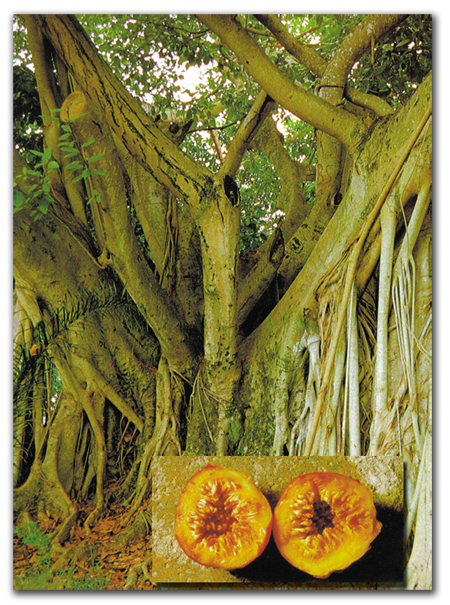 |
|
The strangler fig tree, native to Borneo, shares its life with a kind of wasp. The figs provide an ideal safe shelter for the wasp's eggs. In return, the wasp helps pollinate the fig by carrying the tree's pollen. Strangler figs mature at the same time as the larvae of the wasps. After weeks, male and female wasps hatch from the eggs. The male bites a small hole in the flower's ovary wall. He then inseminates the female through the hole. In the male wasp's short life, his last duty is to open an exit tunnel for the female, and he usually dies as soon as he reaches the surface. The female wasp is then able to leave, and flies to another tree, carrying pollen from her host tree. She enters a ripe fig through an opening at the bottom. In the process of laying her eggs in the ovaries of the flowers, she pollinates the long-styled female flowers. When the female wasp has done her duty, she too dies.
After a time, new wasps hatch from the eggs she's laid, and leave, covered in pollen, by the tunnel previously opened by the male wasp. And to perpetuate the reproductive chain they move on to another fig. (National Geographic, "Borneo's Strangler Fig Trees," Tim Laman, April 1, 1997, p. 41.)
The wasp can't possibly have invented such a complex method of its own accord or taught others how to do this. It is perfectly obvious that the fig's reproductive system has been specially created to live in cooperation with the wasp.
This shows once again that this system has been created by God and that wasps act according to His inspiration.
|
 |
|
Fruit-eating birds have no gizzards and accordingly they do not use pebbles to grind their food. This feature is extremely important, because were the seeds ground in the bird's alimentary tract, they would be destroyed and plants might become extinct. But birds without a gizzard can carry the seeds and let them germinate. Between birds and plants, a symbiotic relationship exists. The plant's seeds are carried by the bird, which it nourishes in return. (Grains de Vie, p. 49.)
Birds sometimes use seeds as a nest-building material, as well as for food. They eat the fleshy part of the fruit, making it easier for seeds inside to germinate by stripping away their outer layer or weakening the casing of tough seeds.
|
The Symbiotic Relationship between the Agouti and the Bertholletia Tree
The seeds of South America’s bertholletia tree, or Brazil nuts, are enclosed in a large round capsule, which, after falling from the tree, lies on the forest floor and remains intact for a time. This is because it has little attraction to many animals; it has no smell, is very hard to break, and there is nothing remarkable about its appearance. But for the nuts inside the capsule to sprout, they must somehow be removed and buried in the soil.
Yet none of this is a problem for the bertholletia tree, because living in the same habitat is a creature with the necessary characteristics to get round these obstacles.
 |
|
Any plant that produces many delicious fruits is an attractive source of nutrition for animals, who can disperse its seeds over a wider area. The relationship between ants and the seed pictured is an example of this. The Creator of this harmonious relationship is God, Who directs the whole affair.
|
The agouti, a South American rodent, knows that there’s something edible inside the thick, odorless capsule. Agoutis’ sharp, pointed teeth can easily break through the hard shells. In every capsule there are about twenty nuts, far more than an agouti can eat at one sitting. So a satisfied agouti carries the nuts in its cheek pouches and digs small holes to store them in and covers them over, much as a squirrel does with acorns. Even though the agouti does this with the intention of eating the nuts later, it never does locate a considerable proportion of the nuts it buries. In this way, the majority of the bertholletia tree’s large heavy seeds are distributed to germinate in the earth.42
The feeding habits of the agouti and the propagation system of the bertholletia tree are remarkably well suited, but this compatibility is not the result of coincidence. These living species have not discovered one another by accident. The bertholletia tree can’t afford the luxury of waiting for such an unconscious coincidence to happen, because this tree has been dependent on the agouti to propagate since the very first day of its existence. It follows that these two species have been created to be compatible with one another.
 |
To clarify this situation with an example, imagine a television with a remote control on the table beside it. You pick up the remote, switch on the TV and flick through the channels. Probably you would assume that the remote control has been designed to control the TV. But what if someone else enters the room and says, “This remote control and the TV have evolved over time as the result of a series of coincidences, and eventually – also by chance – they’ve become compatible.” You’d probably suspect that this person had taken leave of his senses.
Yet the relationship between the bertholletia tree and the agouti is far more complex than between a television and a remote control. The systems of both living species have been organized to be mutually beneficial. And where there is organization, naturally, there is an Organizer.
These living things have been created by one Creator, God. This harmony, just one of the countless examples in nature, is undoubtedly the product of a supreme intelligence. In His unbounded wisdom, God has created these two life forms together with these characteristics.
There is no creature on the Earth which is not dependent upon God for its provision. He knows where it lives and where it dies. They are all in a clear book. (Qur’an, 11:6)
Seeds with Special Protection
 An aril, which looks like a small, fleshy swelling, is the fine protective covering surrounding the seed of some plants. Animals usually devour this protective semi-layer rather than the seed itself. Some of the seeds protected by an aril are as follows: In autumn, the yew tree (Taxus baccata) produces vivid red arils that contrast wonderfully with its dark green needle-like leaves. The arils’ sweet taste is particularly enticing for blackbirds, but they spit out the bitter-tasting seeds. An aril, which looks like a small, fleshy swelling, is the fine protective covering surrounding the seed of some plants. Animals usually devour this protective semi-layer rather than the seed itself. Some of the seeds protected by an aril are as follows: In autumn, the yew tree (Taxus baccata) produces vivid red arils that contrast wonderfully with its dark green needle-like leaves. The arils’ sweet taste is particularly enticing for blackbirds, but they spit out the bitter-tasting seeds.
This is extremely important, since the seeds must be pierced by the birds’ sharp beaks before germination can take place. Should blackbirds swallow the seeds, they are resilient enough to suffer no damage in the birds’ digestive tract. The yew seeds also contain extremely toxic alkaloids, which cause heart failure in living creatures ingesting them. This substance is used as poison on the tips of arrows and also made into toxic preparations, but are often used in treatments – the most important of which are morphine, strychnine and atropine. The spindle tree (Euonymus sp.) produces fruits of an interesting appearance.
When these fruits split open, they are very attractive to birds: the center is white, the seeds are black, and the aril surrounding the fruit is bright orange. This tricolor appearance attracts a wide variety of animal species to the spindle tree. The seeds of the acacia, native to Australia, are dispersed thanks to their nutrient-rich arils that can be red, brown or white and either long or short, according to the variety. The short white or brown ones provide food for ants, which carry the nutritious arils to their nests. On the way, the black seeds sometimes get separated from the aril and fall off. But a lot of seeds are brought to the underground nests, which are at the ideal depth for germination.
The longer red arils, which resemble worms, are eaten by birds. When the broad bean-like fruits split open, the seeds remain clinging to the arils, attracting the birds.40
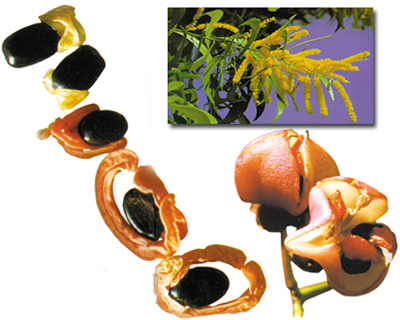 |
|
The seeds of the acacia tree are covered in a kind of nutritious coating called an aril, which is eaten by animals, allowing the seeds to germinate.
|
|








 The geranium (Geranium pusillum) has a most interesting and effective way of reproducing. This variety of plant is a ground creeper, which disperses its seeds by an interesting propulsion method. The fruit of the geranium, which develops to form a spike extending from the fruiting body, acts as a kind of catapult.
The geranium (Geranium pusillum) has a most interesting and effective way of reproducing. This variety of plant is a ground creeper, which disperses its seeds by an interesting propulsion method. The fruit of the geranium, which develops to form a spike extending from the fruiting body, acts as a kind of catapult.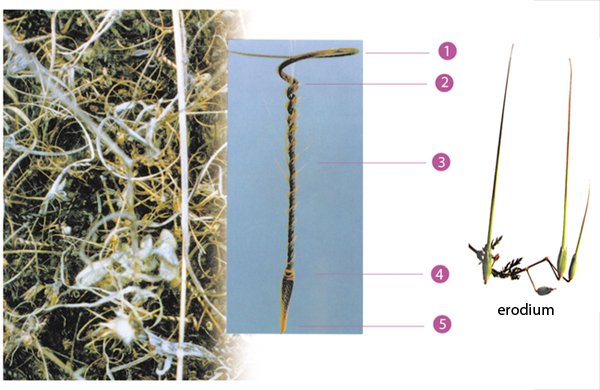




 The Terminalia plant has V-shaped wings.
The Terminalia plant has V-shaped wings.


















 An aril, which looks like a small, fleshy swelling, is the fine protective covering surrounding the seed of some plants. Animals usually devour this protective semi-layer rather than the seed itself. Some of the seeds protected by an aril are as follows: In autumn, the yew tree (Taxus baccata) produces vivid red arils that contrast wonderfully with its dark green needle-like leaves. The arils’ sweet taste is particularly enticing for blackbirds, but they spit out the bitter-tasting seeds.
An aril, which looks like a small, fleshy swelling, is the fine protective covering surrounding the seed of some plants. Animals usually devour this protective semi-layer rather than the seed itself. Some of the seeds protected by an aril are as follows: In autumn, the yew tree (Taxus baccata) produces vivid red arils that contrast wonderfully with its dark green needle-like leaves. The arils’ sweet taste is particularly enticing for blackbirds, but they spit out the bitter-tasting seeds.